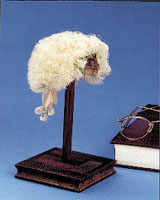British Barrister wigs became popular in the mid-1600’s in France and England, thanks supposedly to Louis XIII, and as principal accoutrements for courtroom attorneys. But the tradition can be traced much further back to medieval times when monks acting in a legal role would wear linen coifs to cover their bald spots. This led to the wearing of skulls caps over the coifs until cornered hats worn over the skulls caps became de rigueur. Solicitors, attorneys who prepare legal documents but rarely appear in court, traditionally did not wear wigs. Barrister wigs come in different styles based on rank: 
The full-bottomed or “Spaniel” wig
Worn by: Queen’s Counsel, Leading Counsel, Judges, Members of the House of Lords Features: The Spaniel wig is the largest wig, lending us the phrase “big wig.” This wig features thick curls that cover the ears and drop down to the shoulders.
The bob wig
Worn by: Judges
Features: frizzed sides with a looped tail hanging down the back.
The tie wig
Worn by: Barristers
Features: Covers half the head, rows of curls on side and back, and a looped tail.
In 2007, the Lord Chief Justice of England and Wales announced money-saving changes to court dress for judges and lawyers. Such was the outrage over the proposal, the sartorial shift was delayed for six months. Since late 2008, the wearing of wigs in civil and family court has been completely abolished, reserving wigs entirely for criminal court. Barrister wigs, now made from white horse hair, are worn by both male and female attorneys.
From an excerpt of The Judge Who Hated Red Nail Polish… via Nolo.
Buy your own from Ede & Ravenscroft.

